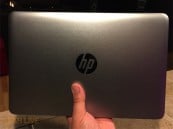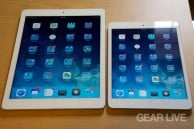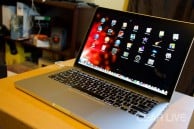CES 2008 Video: Sandisk’s Sansa View and Sansa Clip

Posted by Andru Edwards Categories: Gizmatic, Short Bytes, CES, CES 2008, Features, Movies, Music, Podcasts, Videocasts,
Sandisk never fails to impress with their MP3 players. At CES they were showing off the Sansa View and the Sansa Clip. These new players show up Apple’s current lineup not only in features, but as well as in price. The view’s new hotness: available in capacities up to 32GB (flash based, not hard drive). The clip trounces the iPod shuffle by offering not only 4GB for the price of 1, but also throwing in a screen, FM tuner/recorder, voice recorder, and an equalizer. Both players are available now for half the price (and twice the features) that their Apple made counterparts command - perfect for the thrifty music lover in your life.
Here's how to get the show:|Download| - iPod-formatted H.264
|Download| - Apple TV High Resolution
|Download| - MPEG-4
|Download| - MP3
Advertisement
CES 2008 Video: A Look at Toshiba’s CES SNB HDTV Regza line

Posted by Andru Edwards Categories: Gizmatic, Short Bytes, CES, CES 2008, Features, HDTV, Home Entertainment, Movies, Podcasts, Videocasts,
Toshiba launched a bunch of new Regza LCD HDTV‘s, including the Regza Super Narrow Bezel (SNB) line. We give you a peek at their booth, as well as some of their HD DVD offerings as well.
Here's how to get the show:
|Download| - iPod-formatted H.264
|Download| - Apple TV High Resolution
|Download| - MPEG-4
|Download| - MP3
CES 2008 Video: Sandisk SSD Drive Technology

Posted by Andru Edwards Categories: Gizmatic, Short Bytes, CES, CES 2008, Features, PC / Laptop, Podcasts, Storage, Videocasts,
Many companies showed of Solid State Disks (SSD) at CES, but none so cost effectively as Sandisk. As usual Sandisk is bringing a product to market that beats the price of it’s competitors while still not skimping on features. SSD drives are an effective way to increase performance and battery life on notebooks without requiring re-engineering. Available now in a variety of capacities and price points - look for them in stores or devices soon.
Here's how to get the show:|Download| - iPod-formatted H.264
|Download| - Apple TV High Resolution
|Download| - MPEG-4
|Download| - MP3
CES 2008 Video: Sandisk Cruzer Titanium Plus, Digital Jewelry

Posted by Andru Edwards Categories: Full Episodes, Gizmatic, CES, CES 2008, Features, Handhelds, Home Entertainment, Household, PC / Laptop, Podcasts, Portable Audio / Video, Video Games, Videocasts,
Sandisk is experimenting with doing away with boring old thumb drives in favor of something a little more personal. Their new prototype jewelry is designed as an accessory first, and technology second. Amazingly well hidden within the stylish exterior is a miniscule USB plug for access to it’s treasure trove of digital memories. These are not yet on the market but should be soon - keep your eyes (and pocket book) peeled.
Here's how to get the show:|Download| - iPod-formatted H.264
|Download| - Apple TV High Resolution
|Download| - MPEG-4
|Download| - MP3
Bleeding Edge TV 207: Asus Eee PC RAM Upgrade

Posted by Andru Edwards Categories: Hack Attack, Short Bytes, Features, Handhelds, Mods / Hacks, PC / Laptop, Podcasts, Videocasts,
The Asus Eee PC is an amazing little wonder of a device. However, unless you buy the 8G version, your little Linux mobile laptop isn’t fully powered. Luckily, getting inside the Eee PC is not much of a challenge at all, and adding in some extra RAM typically works nicely for any computer user. In this episode, Nate True show us how to upgrade the RAM in the Eee PC. All you need is a tiny Philips screwdriver, a 1 or 2 GB RAM module, an Eee PC, and a few minutes of time. Check out the video for the full details, and let us know how it goes if you try it out. Remember, we will have more Eee PC tips and hacks for you soon.
Here's how to get the show:|Download| - iPod-formatted H.264
|Download| - Apple TV High Resolution
|Download| - MPEG-4
|Download| - MP3
CES 2008 Video: Tour the AMD Smart House

Posted by Andru Edwards Categories: Full Episodes, Gizmatic, CES, CES 2008, Features, Handhelds, Home Entertainment, Household, PC / Laptop, Podcasts, Portable Audio / Video, Video Games, Videocasts,
While at CES, we got the opportunity to check out the AMD Smart House. The Smart House is a demonstration by AMD of all the different ways that their processors can help enhance day-to-day life of every day consumers. The Mother/Father/Daughter/Sun schtick is a bit thick at times, but the potential of the smart home of the future shines through nonetheless.
Here's how to get the show:|Download| - iPod-formatted H.264
|Download| - Apple TV High Resolution
|Download| - MPEG-4
|Download| - MP3
CES 2008 Video: Samsung’s Q1 Ultra UMPC Line

Posted by Andru Edwards Categories: Full Episodes, Gizmatic, CES, CES 2008, Features, Handhelds, PC / Laptop, Podcasts, Portable Audio / Video, Videocasts,
We visited Samsung and learned about their new Ultra Mobile Personal Computers (UMPC). They’re basically palm-sized computers with the power of a laptop. Their line starts with the Q1 Ultra, which runs Windows XP or Vista has a standard 80GB hard drive, a battery life of 4 ½ hours with WiFi enabled, includes a webcam, 2 USB ports and an SD Card slot, weighing only 1.5 pounds at a price of $1300 USD. There’s also the Q1 Ultra SSD, with a 32 GB solid-state drive for increased boot time and access to data. Finally, there’s the just-launched, award-winning Q1 Ultra Premium, with a powerful Intel Pentium Mobile Processor, 80GB hard drive, and a battery life up to 7.5 hours with WiFi enabled. Available at the end of the month for $1500.
Here's how to get the show:|Download| - iPod-formatted H.264
|Download| - Apple TV High Resolution
|Download| - MPEG-4
|Download| - MP3
CES 2008 Video: Alienware Area 51 M15x Laptop

Posted by Andru Edwards Categories: Gizmatic, Short Bytes, CES, CES 2008, Features, HDTV, Home Entertainment, PC / Laptop, Podcasts, Video Games, Videocasts,
New this week from Alienware is their desktop replacement laptop, the Area 51 M15x. Weighing in at only 7 pounds, with a battery life of 4 hours (and the added bonus of a second battery), and a rear cooling system, the M15x is the only 15” laptop to feature Intel’s Core 2 Extreme 2.8 gHz processor.
With a screen resolution of 1920x1080, the M15x sports true 1080p to fully exploit the binary graphics - it can switch between its NVIDIA 8800 512 mhz graphics card and its integrated Intel card, which is perfect for getting the most out of DVDs viewed on the integrated Blu-Ray player. It also has an HDMI output to enjoy those Blu-Ray movies on a big screen. Alienware’s Area 51 M15x is available at a price point of around $2200 to $2300.
Here's how to get the show:|Download| - iPod-formatted H.264
|Download| - Apple TV High Resolution
|Download| - MPEG-4
|Download| - MP3
CES 2008 Video: A Hands-On look at the AMD Puma Notebook platform

Posted by Andru Edwards Categories: Full Episodes, Gizmatic, CES, CES 2008, Corporate News, Features, PC / Laptop, Podcasts, Videocasts,
We take a close look at AMD‘s recently announced “Puma” notebook platform. Puma is a tightly-knit system for notebook suppliers comprising of the chipset, CPU, GPU and wireless chipset. Similar in some ways to their Spider desktop platform, Puma takes it to the next level by allowing for a hybrid integrated and discreet graphics solution. While Intel has something similar, AMD is apparently the first to offer a dynamically switchable system, allowing your notebook to automatically switch to integrated graphics when it detects you’ve gone on battery, or to allow you to switch manually. I asked if they plan on making it automatic, based on load, which they seemed to think was a pretty great idea and relatively easy to achieve as well. What’s more, despite the fact that the integrated and discreet GPUs are chips of differing abilities and specs, they’re still able to operate in Crossfire/hybrid mode, providing an extra boost in power and achieving some very impressive framerates.
AMD shows us their reference bench system and two other identically-configured systems, the only difference between them an Intel versus AMD integrated graphics chipset. (And CPU, naturally.) With a price difference of around $25 to AMD’s favor, the AMD integrated chip actually performs considerably better in their demo, grain of salt included. The reference system shows off their hybrid processing and lets us see what framerates we might be able to hit on an entry- to mid-level hybrid Puma system.
Puma also brings about something that’s been announced with Intel as well—the ability to deactivate CPU cores and speeds, instead of just stepping down speed. This, coupled with an intelligent HD decoder will bring about several hours of additional battery life.
Here's how to get the show:|Download| - iPod-formatted H.264
|Download| - Apple TV High Resolution
|Download| - MPEG-4
|Download| - MP3
CES 2008 Video: AMD Spider platform, Dual-Chip Radeon R870

Posted by Andru Edwards Categories: Full Episodes, Gizmatic, CES, CES 2008, Corporate News, Features, PC / Laptop, Peripherals, Podcasts, Video Games, Videocasts,
We take a few moments with AMD‘s Rick Bergman, General Manager of the Graphics Processing Group, about their new Spider platform—a three-tiered computing system that helps tie together and ensure compatibility between the chipset, CPU and GPU. We talk about what sort of benefits this means to the enthusiast-class consumer. We also dive into the nitty-gritty with the new Radeon, currently codenamed the R870—a dual chip design that has two separate GPU units with an internal Crossfire link and Alternate-Frame Rendering to tie them together. I also ask about some of the design challenges realized in smashing two cards together and getting an efficient, workable result. The design is impressive and the ability to link two of these cards together will come to mean a great deal of graphics processing power in the near future.
The card will be available late January and can be powered in a typical system by a 500 watt power supply; ATI has cut their power requirements for similarly powered cards in half, without sacrificing any performance.
Here's how to get the show:|Download| - iPod-formatted H.264
|Download| - Apple TV High Resolution
|Download| - MPEG-4
|Download| - MP3
Advertisement
© Gear Live Media, LLC. 2007 – User-posted content, unless source is quoted, is licensed under a Creative Commons Public Domain License. Gear Live graphics, logos, designs, page headers, button icons, videos, articles, blogs, forums, scripts and other service names are the trademarks of Gear Live Inc.










